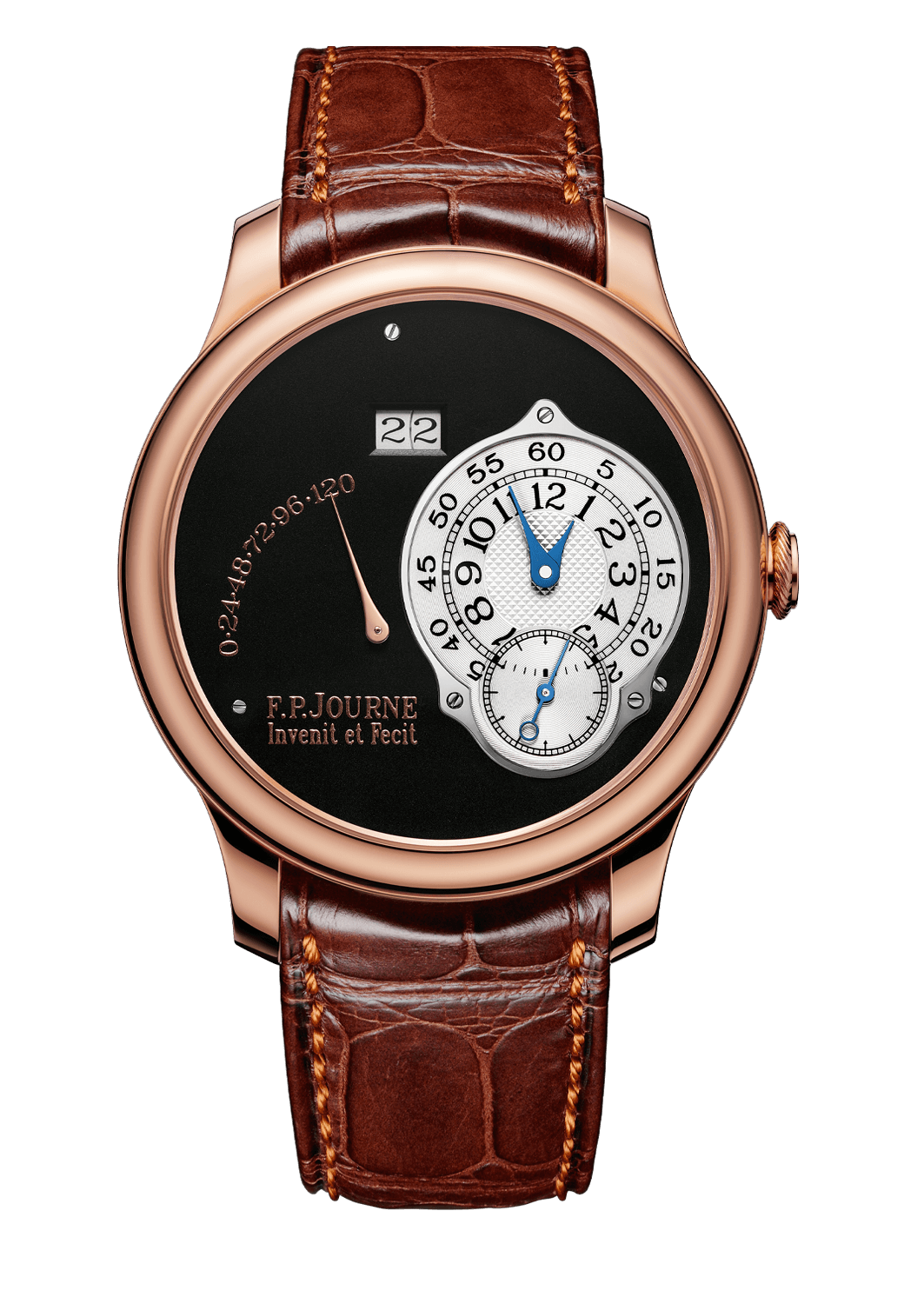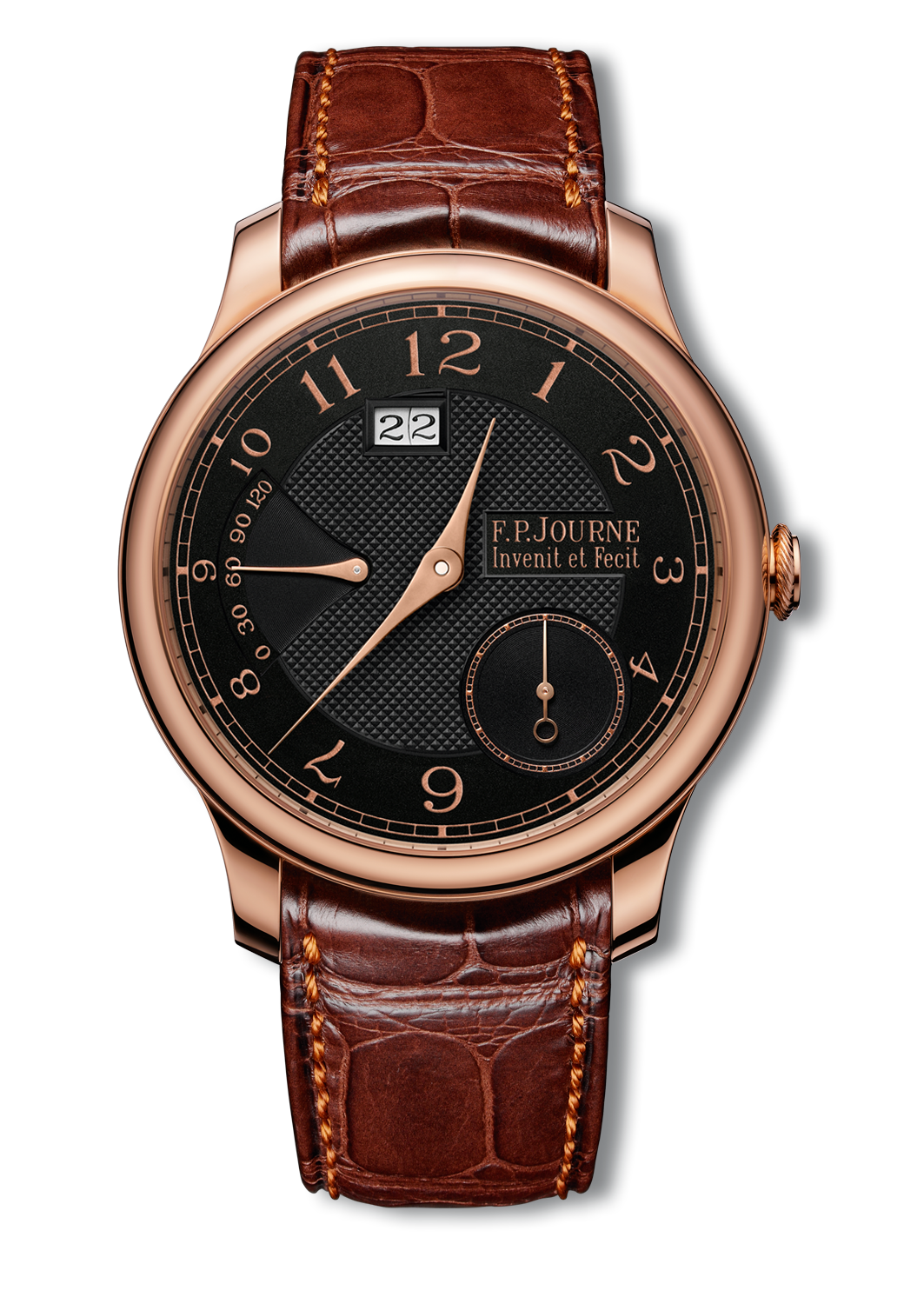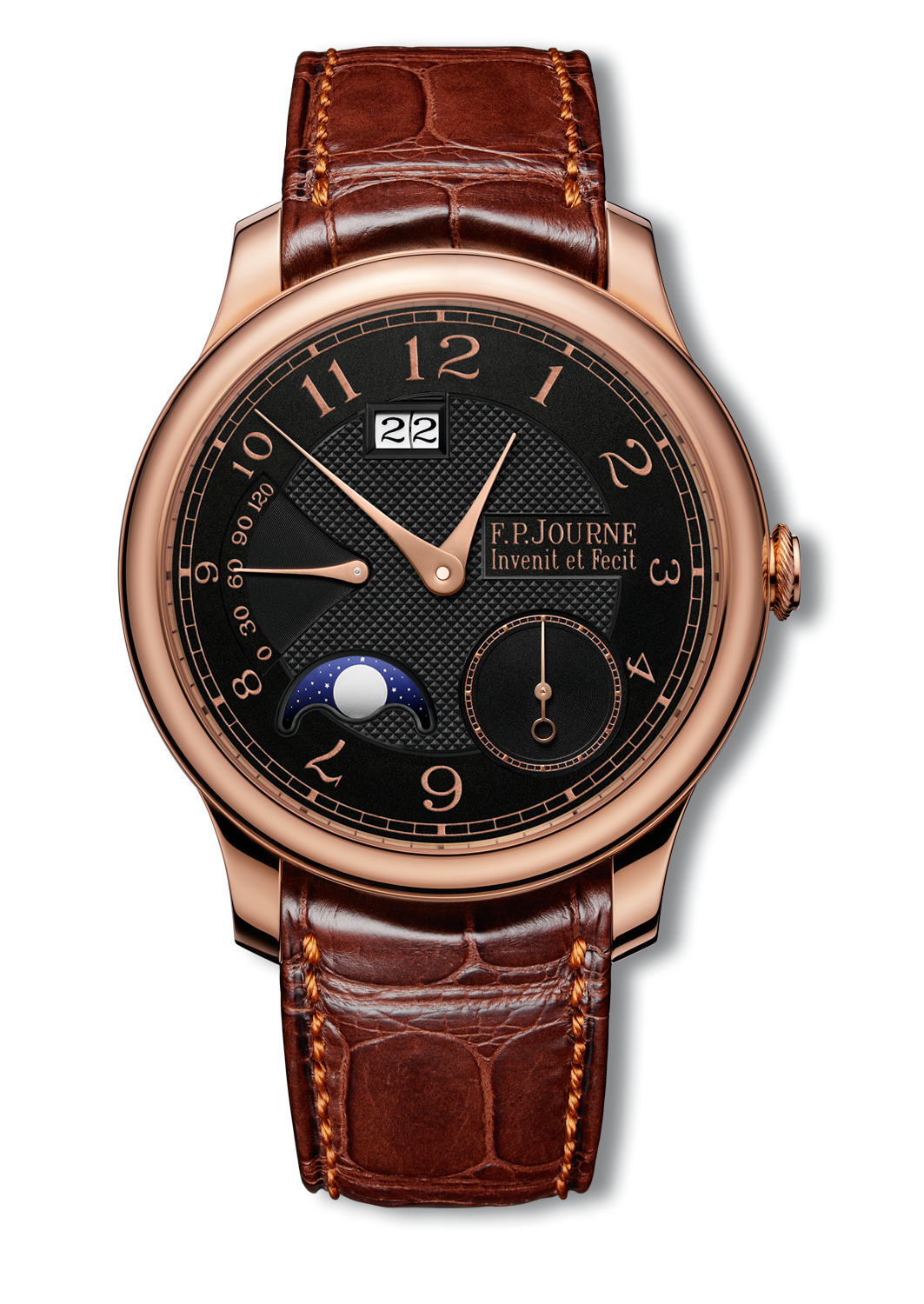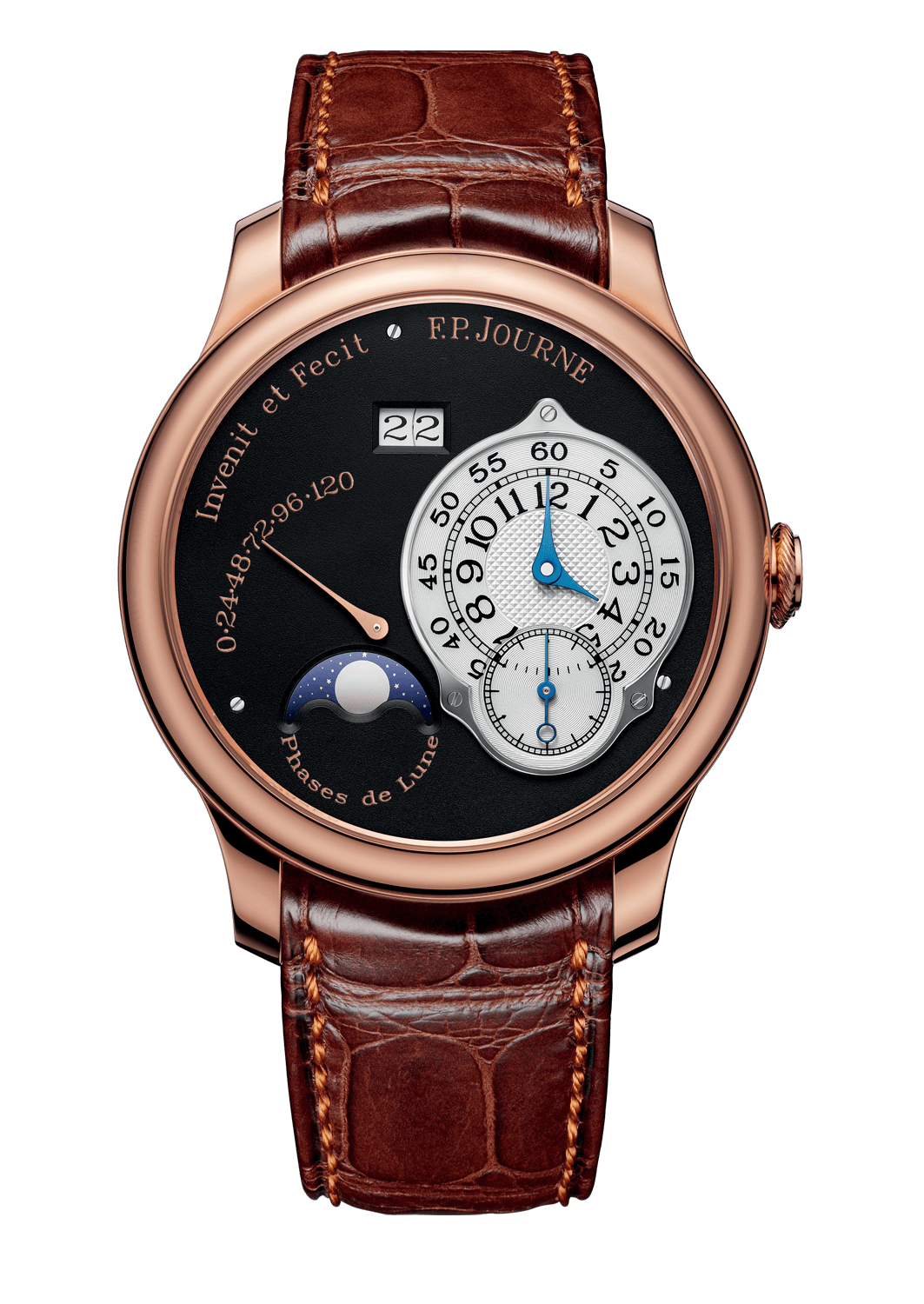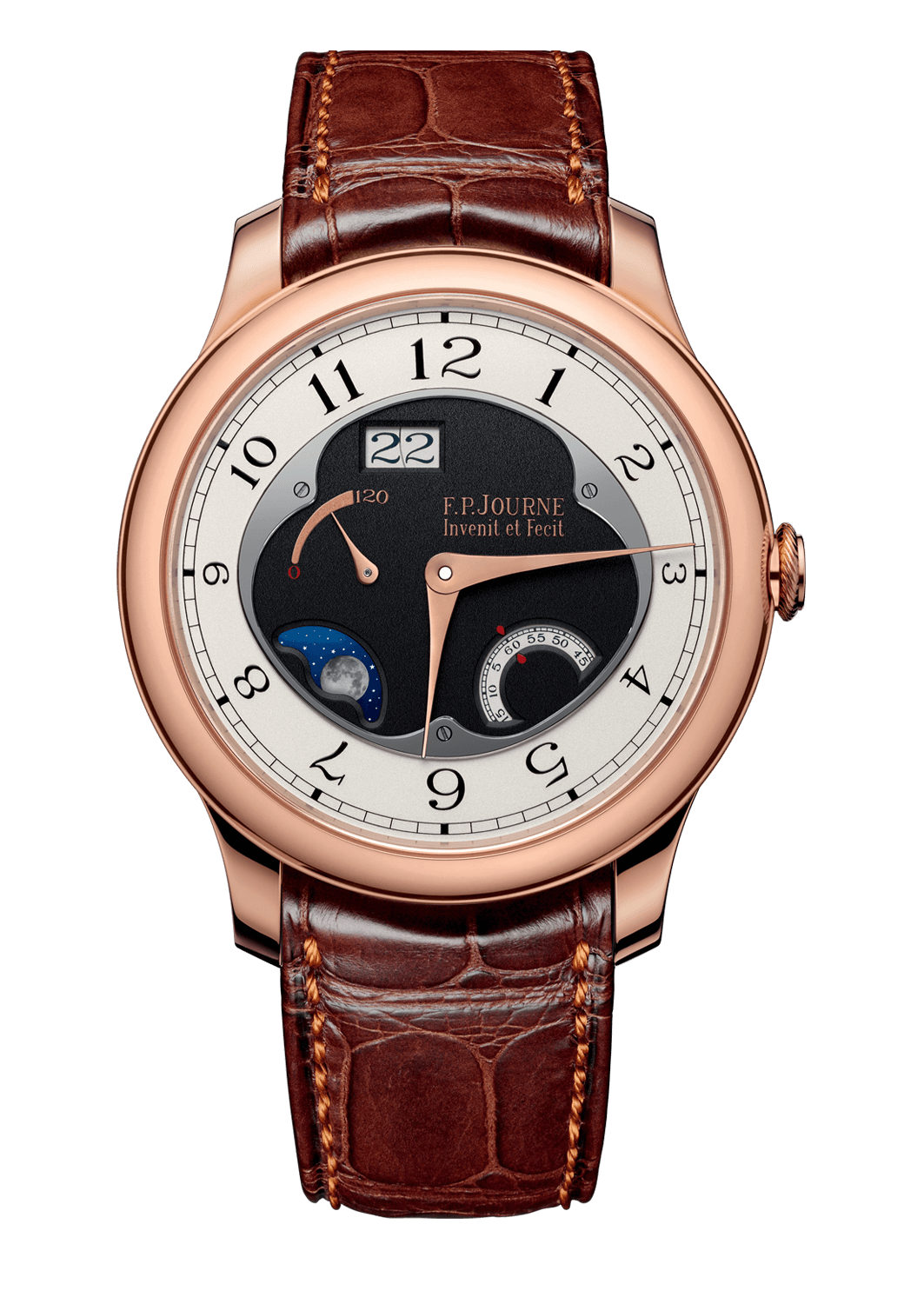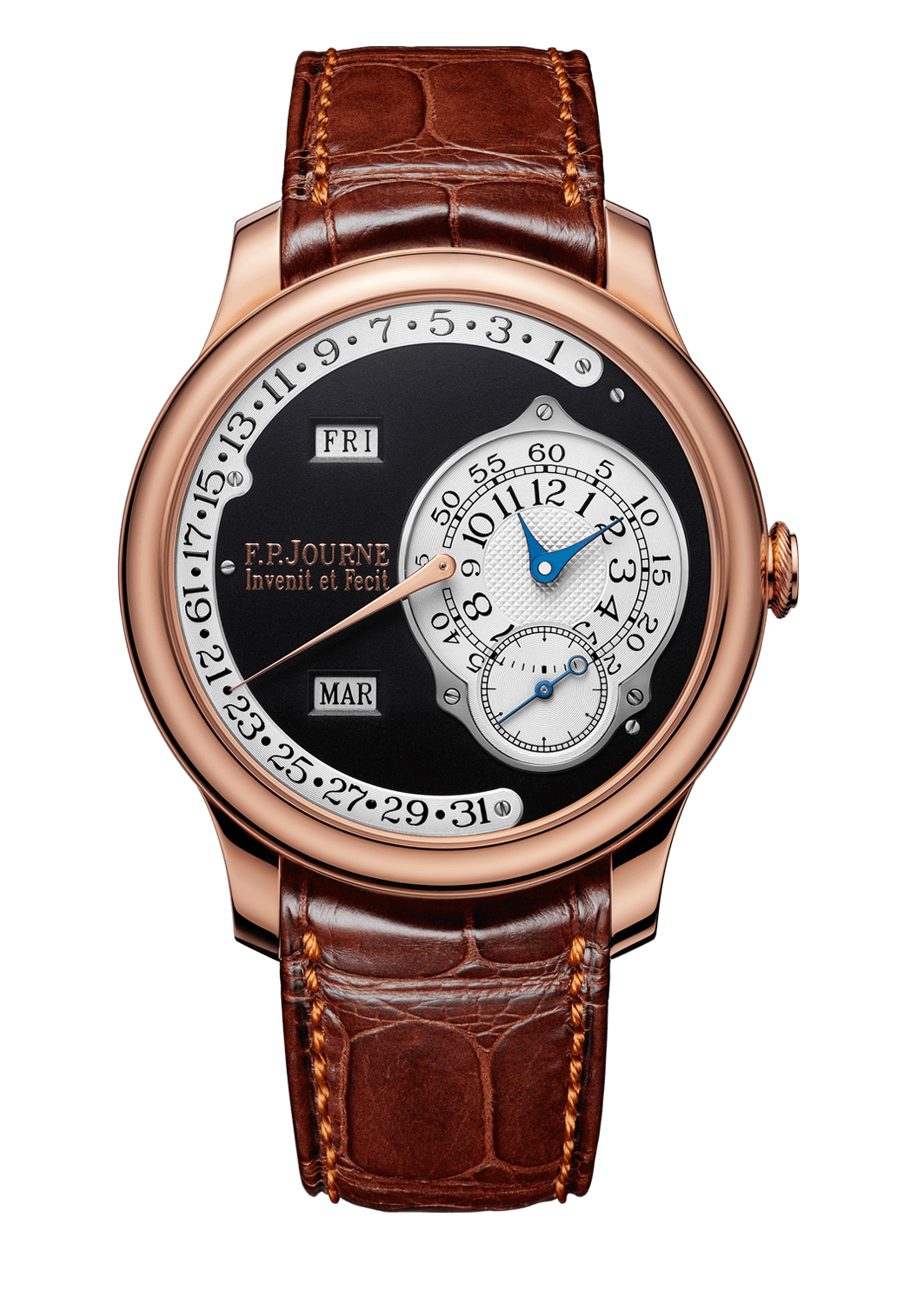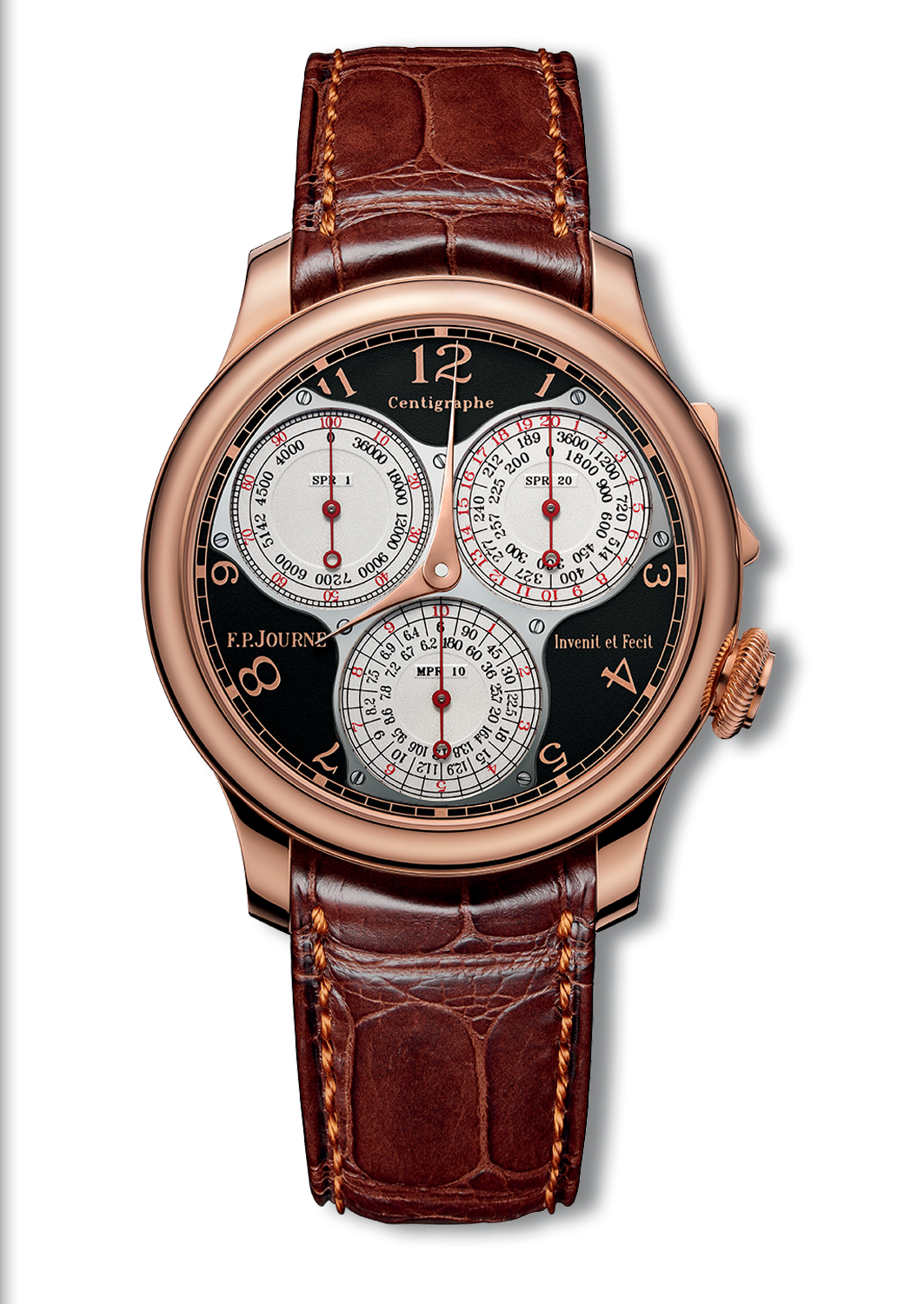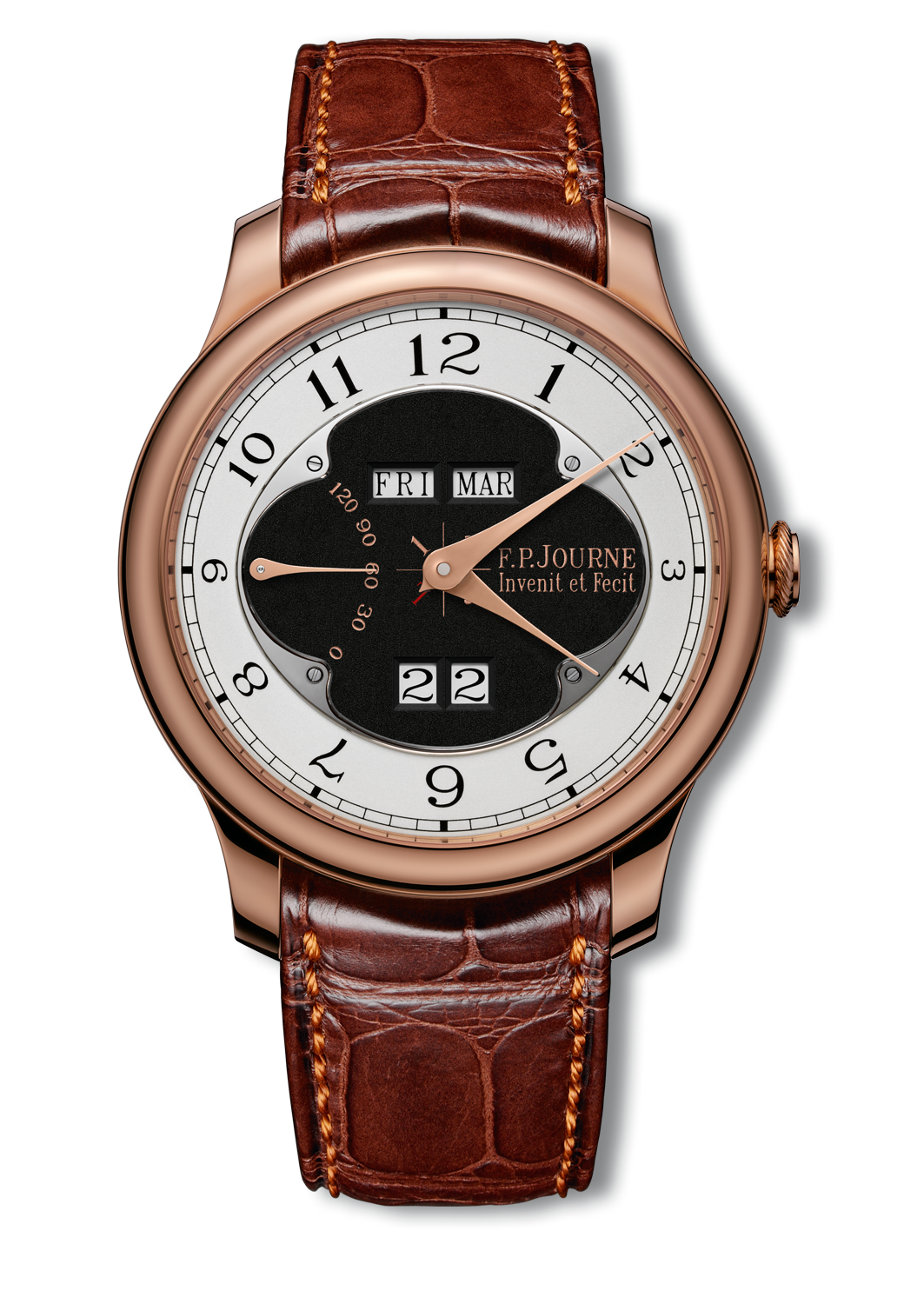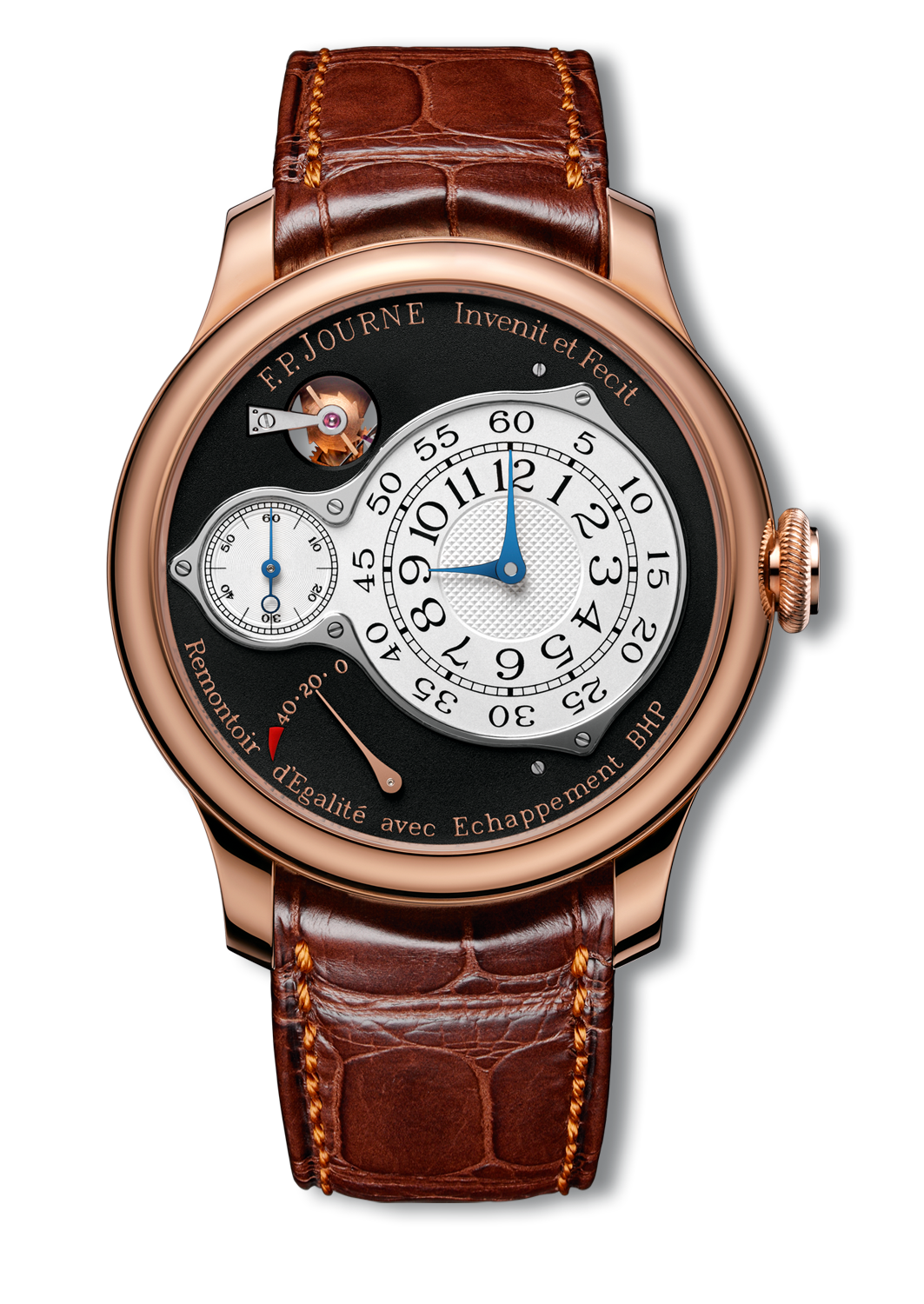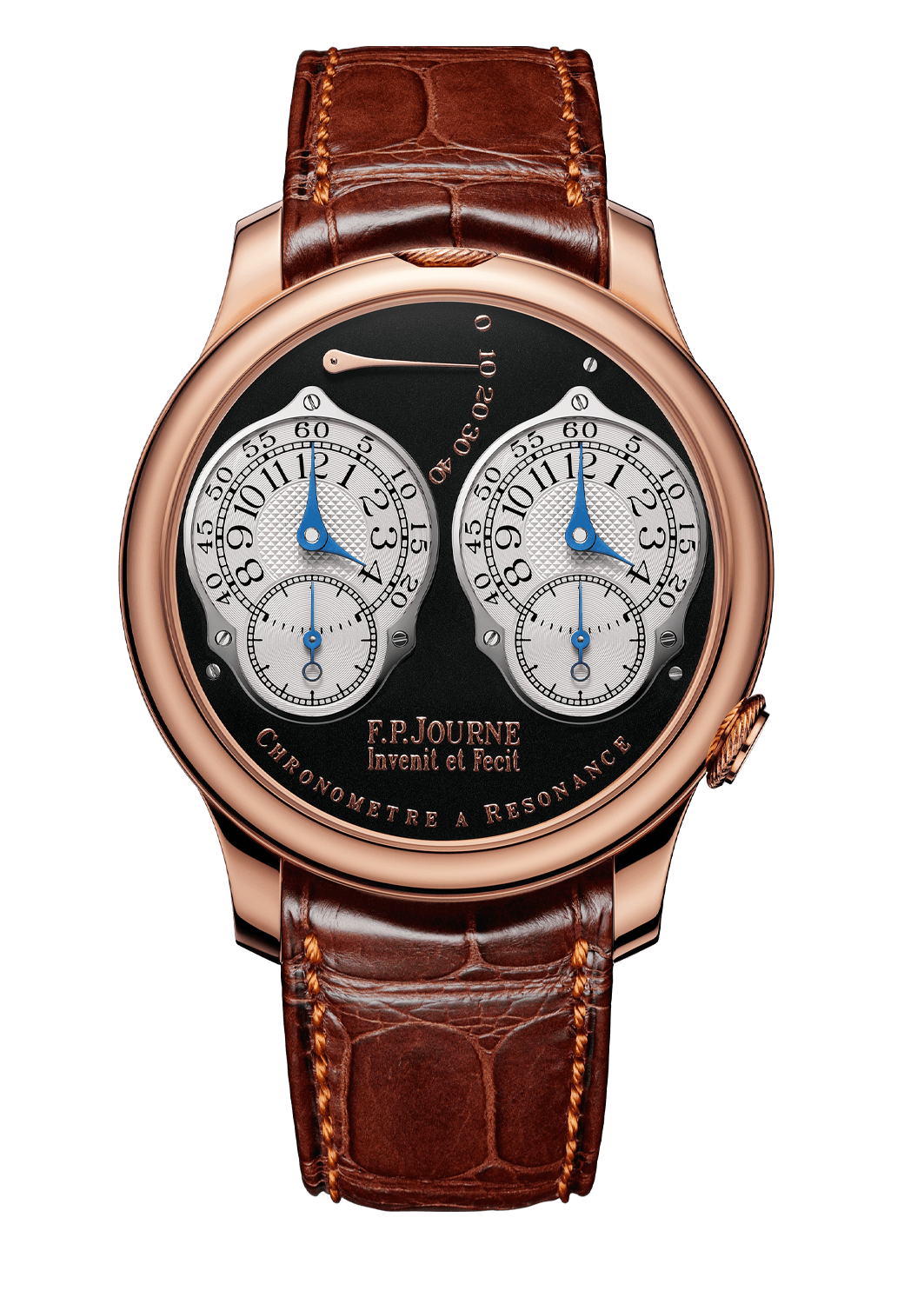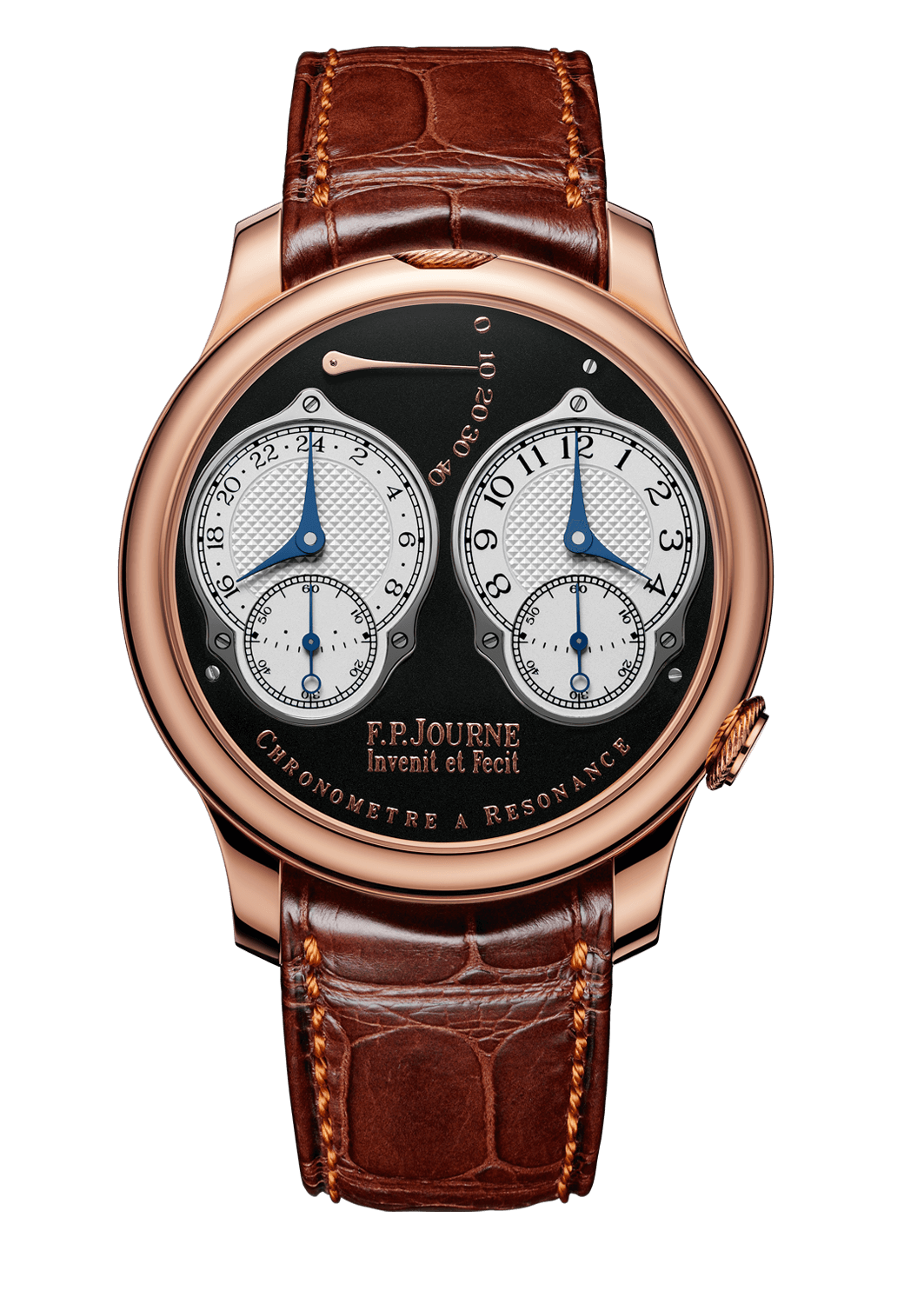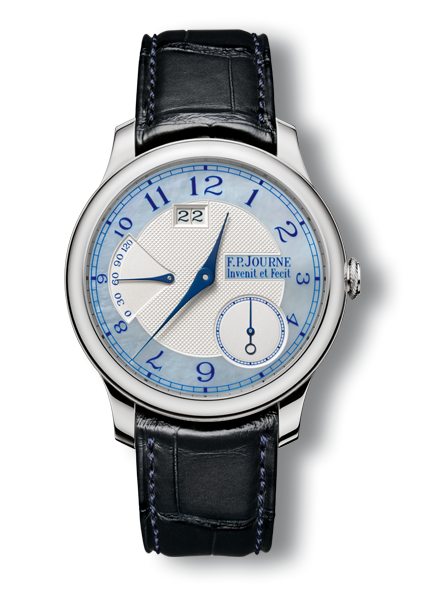Calibre 1499.2 https://www.fpjourne.com/en/collection/boutique-collection/boutique-edition-chronometre-resonance-1 FP Journe https://www.fpjourne.com/en FP Journe

Diameter: 40 or 42 mm
Overall height: 10.8 mm
Dial: blackened Gold and whitened guilloché Silver (analog 12 hours)
Hands: blued Steel and 5N gilt Steel
Technical Specifications
- Winding : Manual
- 18K rose gold : 36 jewels
- Overall diameter : 32.60 mm
- Casing-up diameter : 32.0 mm
- Overall height : 4.50 mm
- Height of winding system : 2.59 mm
- Diameter of stem thread : S1.00mm
- Diameter of reset to zero stem : S1.20mm
2 x linear escapements, 15 teeth
2 x balances with 4 inertia weight
2 x flat microflamed Anachron balance Spring
2 x mobile stud carriers
2 x free sprung balance springs
2x spring laser pinned to Nivatronic collets
Pinned GE studs
2 position winding crown
Reset to zero button for seconds
21 600 Alt/h (3Hz)
10.10 mg/cm2
52°
0h dial up: 320°
24h dial up: 270°
Manual winding, 27 turns of crown
Time adjustment at 12h for left dial by winding crown on position 2 in one direction, and in the opposite direction for right dial
Reset both seconds to zero by pulling button at 4h00
Double display:
Left dial –digital - indicating 24 hours
Right dial – analogic- indicating 12 hours
2 small seconds at 6h00
Power reserve at 11h00
40 ± 2 hours
High quality
Partial circular graining on baseplate
Screw heads polished and bevelled, with chamfered slots
Pegs with polished rounded ends
Movement without dial: 299
Cased up with strap: 336
- Winding : Manual
- 18K rose gold : 36 jewels
- Overall diameter : 32.60 mm
- Casing-up diameter : 32.0 mm
- Overall height : 4.50 mm
- Height of winding system : 2.59 mm
- Diameter of stem thread : S1.00mm
- Diameter of reset to zero stem : S1.20mm
2 x linear escapements, 15 teeth
2 x balances with 4 inertia weight
2 x flat microflamed Anachron balance Spring
2 x mobile stud carriers
2 x free sprung balance springs
2x spring laser pinned to Nivatronic collets
Pinned GE studs
2 position winding crown
Reset to zero button for seconds
21 600 Alt/h (3Hz)
10.10 mg/cm2
52°
0h dial up: 320°
24h dial up: 270°
Manual winding, 27 turns of crown
Time adjustment at 12h for left dial by winding crown on position 2 in one direction, and in the opposite direction for right dial
Reset both seconds to zero by pulling button at 4h00
Double display:
Left dial –digital - indicating 24 hours
Right dial – analogic- indicating 12 hours
2 small seconds at 6h00
Power reserve at 11h00
40 ± 2 hours
High quality
Partial circular graining on baseplate
Screw heads polished and bevelled, with chamfered slots
Pegs with polished rounded ends
Movement without dial: 299
Cased up with strap: 336
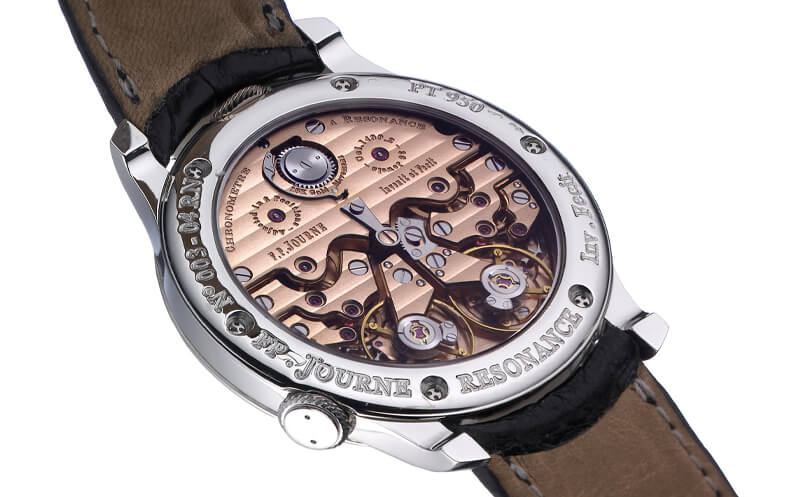
Technical description
François-Paul Journe pays tribute to the research conducted on resonance by the great 18th century watchmakers, with the presentation of the first wristwatch resonance chronometer.
In 1983, François-Paul Journe took up the challenge with a first creation in the form of a pocket-watch, which did not yet perform according to his expectations. It would take fifteen more years of work for the watchmaker to gain the maturity and the experience to enable him to present an exclusive world première, the first resonance wristwatch.

Technical description
François-Paul Journe pays tribute to the research conducted on resonance by the great 18th century watchmakers, with the presentation of the first wristwatch resonance chronometer.
In 1983, François-Paul Journe took up the challenge with a first creation in the form of a pocket-watch, which did not yet perform according to his expectations. It would take fifteen more years of work for the watchmaker to gain the maturity and the experience to enable him to present an exclusive world première, the first resonance wristwatch.
Diameter: 40 or 42 mm
Overall height: 10.8 mm
Dial: blackened Gold and whitened guilloché Silver (analog 12 hours)
Hands: blued Steel and 5N gilt Steel

Diameter: 40 or 42 mm
Overall height: 10.8 mm
Dial: blackened Gold and whitened guilloché Silver (analog 12 hours)
Hands: blued Steel and 5N gilt Steel
Technical Specifications
- Winding : Manual
- 18K rose gold : 36 jewels
- Overall diameter : 32.60 mm
- Casing-up diameter : 32.0 mm
- Overall height : 4.50 mm
- Height of winding system : 2.59 mm
- Diameter of stem thread : S1.00mm
- Diameter of reset to zero stem : S1.20mm
2 x linear escapements, 15 teeth
2 x balances with 4 inertia weight
2 x flat microflamed Anachron balance Spring
2 x mobile stud carriers
2 x free sprung balance springs
2x spring laser pinned to Nivatronic collets
Pinned GE studs
2 position winding crown
Reset to zero button for seconds
21 600 Alt/h (3Hz)
10.10 mg/cm2
52°
0h dial up: 320°
24h dial up: 270°
Manual winding, 27 turns of crown
Time adjustment at 12h for left dial by winding crown on position 2 in one direction, and in the opposite direction for right dial
Reset both seconds to zero by pulling button at 4h00
Double display:
Left dial –digital - indicating 24 hours
Right dial – analogic- indicating 12 hours
2 small seconds at 6h00
Power reserve at 11h00
40 ± 2 hours
High quality
Partial circular graining on baseplate
Screw heads polished and bevelled, with chamfered slots
Pegs with polished rounded ends
Movement without dial: 299
Cased up with strap: 336
- Winding : Manual
- 18K rose gold : 36 jewels
- Overall diameter : 32.60 mm
- Casing-up diameter : 32.0 mm
- Overall height : 4.50 mm
- Height of winding system : 2.59 mm
- Diameter of stem thread : S1.00mm
- Diameter of reset to zero stem : S1.20mm
2 x linear escapements, 15 teeth
2 x balances with 4 inertia weight
2 x flat microflamed Anachron balance Spring
2 x mobile stud carriers
2 x free sprung balance springs
2x spring laser pinned to Nivatronic collets
Pinned GE studs
2 position winding crown
Reset to zero button for seconds
21 600 Alt/h (3Hz)
10.10 mg/cm2
52°
0h dial up: 320°
24h dial up: 270°
Manual winding, 27 turns of crown
Time adjustment at 12h for left dial by winding crown on position 2 in one direction, and in the opposite direction for right dial
Reset both seconds to zero by pulling button at 4h00
Double display:
Left dial –digital - indicating 24 hours
Right dial – analogic- indicating 12 hours
2 small seconds at 6h00
Power reserve at 11h00
40 ± 2 hours
High quality
Partial circular graining on baseplate
Screw heads polished and bevelled, with chamfered slots
Pegs with polished rounded ends
Movement without dial: 299
Cased up with strap: 336

Technical description
François-Paul Journe pays tribute to the research conducted on resonance by the great 18th century watchmakers, with the presentation of the first wristwatch resonance chronometer.
In 1983, François-Paul Journe took up the challenge with a first creation in the form of a pocket-watch, which did not yet perform according to his expectations. It would take fifteen more years of work for the watchmaker to gain the maturity and the experience to enable him to present an exclusive world première, the first resonance wristwatch.

Technical description
François-Paul Journe pays tribute to the research conducted on resonance by the great 18th century watchmakers, with the presentation of the first wristwatch resonance chronometer.
In 1983, François-Paul Journe took up the challenge with a first creation in the form of a pocket-watch, which did not yet perform according to his expectations. It would take fifteen more years of work for the watchmaker to gain the maturity and the experience to enable him to present an exclusive world première, the first resonance wristwatch.
About
THE CHRONOMÈTRE À RÉSONANCE BOUTIQUE EDITION WITH BLACK DIAL ON 18K 6N GOLD CASE IS AVAILABLE ONLY IN THE F.P.JOURNE BOUTIQUES AND ESPACES AROUND THE WORLD.
THE FIRST OBSERVATIONS PERTAINING TO THE NATURAL RESONANCE PHENOMENON WERE MADE BY 17TH CENTURY DUTCH SCIENTIST CHRISTIAAN HUYGENS, FOLLOWED BY 18TH CENTURY HOROLOGISTS ANTIDE JANVIER AND ABRAHAM-LOUIS BREGUET, WHO DEVELOPED TIMEPIECES BASED UPON THIS PRINCIPLE. SINCE THEN, FRANÇOIS-PAUL JOURNE PRESENTED HIS FIRST RÉSONANCE WRISTWATCH IN 2000, IT WAS BAPTIZED RÉSONANCE UNDER THE PATENTED BRAND NAME RÉSONANCE®.
THE F.P.JOURNE CHRONOMÈTRE À RÉSONANCE IS THE ONLY WRISTWATCH IN THE WORLD THAT UTILIZES THE PHYSICAL NATURAL RESONANCE WITHOUT ANY MECHANICAL TRANSMISSION PHENOMENON, PREVIOUSLY KNOWN AS DOUBLE PENDULUM OR DOUBLE BALANCE.
MOVING TOWARDS MORE PRECISION, ALWAYS!
"I will try to explain the historical reasons that led me to build such or such a watch. As far as the resonance phenomenon is concerned, the intuition that energy is dissipated without being lost goes back to the 18th century and the research performed by the great chemist Lavoisier, who stated in his famous theory which highlights my modest explanations: "Nothing is lost, nothing is created, everything is transformed". With the invention of the pendulum, watchmakers noticed that their beat often interfered with their environment and it was not unusual for a pendulum clock to stop of its own accord when the pendulum came into resonance with the driving-weight suspended from its cords.
After the theories of Christiaan Huygens, The brilliant watchmaker or "mechanical engineer" as he described himself, who was the first to have the feeling that one might use turn this disadvantage into an asset: Antide Janvier, born in 1751 in St Claude, France. His idea was to build two complete movements with two precision escapements and to place them close to each other, ensuring that the two pendulums were hanging from the same construction. Just as he imagined, the pendulums recovered the energy dissipated by each other and began to beat together, thus entering into resonance. Maintained by this wave and thus protected from outside vibrations, this principle considerably enhanced their precision. About 1780, Antide Janvier built two precision regulators, one of which is preserved at the Paul Dupuy museum in Toulouse and the second in the private collection of Montres Journes SA, Geneva. A third desk-top regulator is kept in the Patek Philippe Museum in Geneva. Thirty years later, Abraham-Louis Breguet built a resonance regulator for Louis XVIII, King of France, which is now part of the collection of the Musée des Arts et Métiers in Paris; and a second for the King of England, Georges III, which is housed in Buckingham Palace. He also made a pocket-watch based on the same principle for each of these illustrious figures. To my knowledge, no-one else in watchmaking took any further interest in this fascinating physical phenomenon! The advantages of this phenomenon in terms of precision led me to pursue my own personal research and attempts which, after fifteen years, enabled me to adapt it to a wristwatch, the Chronomètre à Résonance. I felt that this resonance system was particularly well suited to the various wrist movements that subject watch mechanisms to repeated jarring which is detrimental to their smooth running.
The new Chronomètre à Résonance has only one single barrel spring to provide power for the two movements. A differential placed on the first wheel, visible in the centre of the dial, transmits, independently, the energy of the barrel spring towards the two secondary gear trains. Each secondary gear train is equipped with a Remontoir d’Egalité of a frequency of 1 second. Working in such a way, the force received by the escapements remains linear and assures isochronism throughout 28 hours".
François-Paul Journe
Technical Specifications
- Winding : Manual
- 18K rose gold : 36 jewels
- Overall diameter : 32.60 mm
- Casing-up diameter : 32.0 mm
- Overall height : 4.50 mm
- Height of winding system : 2.59 mm
- Diameter of stem thread : S1.00mm
- Diameter of reset to zero stem : S1.20mm
2 x linear escapements, 15 teeth
2 x balances with 4 inertia weight
2 x flat microflamed Anachron balance Spring
2 x mobile stud carriers
2 x free sprung balance springs
2x spring laser pinned to Nivatronic collets
Pinned GE studs
2 position winding crown
Reset to zero button for seconds
21 600 Alt/h (3Hz)
10.10 mg/cm2
52°
0h dial up: 320°
24h dial up: 270°
Manual winding, 27 turns of crown
Time adjustment at 12h for left dial by winding crown on position 2 in one direction, and in the opposite direction for right dial
Reset both seconds to zero by pulling button at 4h00
Double display:
Left dial –digital - indicating 24 hours
Right dial – analogic- indicating 12 hours
2 small seconds at 6h00
Power reserve at 11h00
40 ± 2 hours
High quality
Partial circular graining on baseplate
Screw heads polished and bevelled, with chamfered slots
Pegs with polished rounded ends
Movement without dial: 299
Cased up with strap: 336
- Winding : Manual
- 18K rose gold : 36 jewels
- Overall diameter : 32.60 mm
- Casing-up diameter : 32.0 mm
- Overall height : 4.50 mm
- Height of winding system : 2.59 mm
- Diameter of stem thread : S1.00mm
- Diameter of reset to zero stem : S1.20mm
2 x linear escapements, 15 teeth
2 x balances with 4 inertia weight
2 x flat microflamed Anachron balance Spring
2 x mobile stud carriers
2 x free sprung balance springs
2x spring laser pinned to Nivatronic collets
Pinned GE studs
2 position winding crown
Reset to zero button for seconds
21 600 Alt/h (3Hz)
10.10 mg/cm2
52°
0h dial up: 320°
24h dial up: 270°
Manual winding, 27 turns of crown
Time adjustment at 12h for left dial by winding crown on position 2 in one direction, and in the opposite direction for right dial
Reset both seconds to zero by pulling button at 4h00
Double display:
Left dial –digital - indicating 24 hours
Right dial – analogic- indicating 12 hours
2 small seconds at 6h00
Power reserve at 11h00
40 ± 2 hours
High quality
Partial circular graining on baseplate
Screw heads polished and bevelled, with chamfered slots
Pegs with polished rounded ends
Movement without dial: 299
Cased up with strap: 336

Technical description
François-Paul Journe pays tribute to the research conducted on resonance by the great 18th century watchmakers, with the presentation of the first wristwatch resonance chronometer.
In 1983, François-Paul Journe took up the challenge with a first creation in the form of a pocket-watch, which did not yet perform according to his expectations. It would take fifteen more years of work for the watchmaker to gain the maturity and the experience to enable him to present an exclusive world première, the first resonance wristwatch.

Technical description
François-Paul Journe pays tribute to the research conducted on resonance by the great 18th century watchmakers, with the presentation of the first wristwatch resonance chronometer.
In 1983, François-Paul Journe took up the challenge with a first creation in the form of a pocket-watch, which did not yet perform according to his expectations. It would take fifteen more years of work for the watchmaker to gain the maturity and the experience to enable him to present an exclusive world première, the first resonance wristwatch.
-
About
THIS MODEL WAS PRODUCED BETWEEN 2007 AND 2011.
THE CHRONOMÈTRE À RÉSONANCE BOUTIQUE EDITION WITH BLACK DIAL ON 18K 6N GOLD CASE IS AVAILABLE ONLY IN THE F.P.JOURNE BOUTIQUES AND ESPACES AROUND THE WORLD.
THE FIRST OBSERVATIONS PERTAINING TO THE NATURAL RESONANCE PHENOMENON WERE MADE BY 17TH CENTURY DUTCH SCIENTIST CHRISTIAAN HUYGENS, FOLLOWED BY 18TH CENTURY HOROLOGISTS ANTIDE JANVIER AND ABRAHAM-LOUIS BREGUET, WHO DEVELOPED TIMEPIECES BASED UPON THIS PRINCIPLE. SINCE THEN, FRANÇOIS-PAUL JOURNE PRESENTED HIS FIRST RÉSONANCE WRISTWATCH IN 2000, IT WAS BAPTIZED RÉSONANCE UNDER THE PATENTED BRAND NAME RÉSONANCE®.
THE F.P.JOURNE CHRONOMÈTRE À RÉSONANCE IS THE ONLY WRISTWATCH IN THE WORLD THAT UTILIZES THE PHYSICAL NATURAL RESONANCE WITHOUT ANY MECHANICAL TRANSMISSION PHENOMENON, PREVIOUSLY KNOWN AS DOUBLE PENDULUM OR DOUBLE BALANCE.
MOVING TOWARDS MORE PRECISION, ALWAYS!
-
Testimony
Chronomètre à Résonance
"I will try to explain the historical reasons that led me to build such or such a watch. As far as the resonance phenomenon is concerned, the intuition that energy is dissipated without being lost goes back to the 18th century and the research performed by the great chemist Lavoisier, who stated in his famous theory which highlights my modest explanations: "Nothing is lost, nothing is created, everything is transformed". With the invention of the pendulum, watchmakers noticed that their beat often interfered with their environment and it was not unusual for a pendulum clock to stop of its own accord when the pendulum came into resonance with the driving-weight suspended from its cords.
After the theories of Christiaan Huygens, The brilliant watchmaker or "mechanical engineer" as he described himself, who was the first to have the feeling that one might use turn this disadvantage into an asset: Antide Janvier, born in 1751 in St Claude, France. His idea was to build two complete movements with two precision escapements and to place them close to each other, ensuring that the two pendulums were hanging from the same construction. Just as he imagined, the pendulums recovered the energy dissipated by each other and began to beat together, thus entering into resonance. Maintained by this wave and thus protected from outside vibrations, this principle considerably enhanced their precision. About 1780, Antide Janvier built two precision regulators, one of which is preserved at the Paul Dupuy museum in Toulouse and the second in the private collection of Montres Journes SA, Geneva. A third desk-top regulator is kept in the Patek Philippe Museum in Geneva. Thirty years later, Abraham-Louis Breguet built a resonance regulator for Louis XVIII, King of France, which is now part of the collection of the Musée des Arts et Métiers in Paris; and a second for the King of England, Georges III, which is housed in Buckingham Palace. He also made a pocket-watch based on the same principle for each of these illustrious figures. To my knowledge, no-one else in watchmaking took any further interest in this fascinating physical phenomenon! The advantages of this phenomenon in terms of precision led me to pursue my own personal research and attempts which, after fifteen years, enabled me to adapt it to a wristwatch, the Chronomètre à Résonance. I felt that this resonance system was particularly well suited to the various wrist movements that subject watch mechanisms to repeated jarring which is detrimental to their smooth running.
The new Chronomètre à Résonance has only one single barrel spring to provide power for the two movements. A differential placed on the first wheel, visible in the centre of the dial, transmits, independently, the energy of the barrel spring towards the two secondary gear trains. Each secondary gear train is equipped with a Remontoir d’Egalité of a frequency of 1 second. Working in such a way, the force received by the escapements remains linear and assures isochronism throughout 28 hours".
François-Paul Journe -
Technical description
Technical Specifications
Movement :- Winding : Manual
- 18K rose gold : 36 jewels
Dimensions :- Overall diameter : 32.60 mm
- Casing-up diameter : 32.0 mm
- Overall height : 4.50 mm
- Height of winding system : 2.59 mm
- Diameter of stem thread : S1.00mm
- Diameter of reset to zero stem : S1.20mm
Characteristics :2 x linear escapements, 15 teeth
2 x balances with 4 inertia weight
2 x flat microflamed Anachron balance Spring
2 x mobile stud carriers
2 x free sprung balance springs
2x spring laser pinned to Nivatronic collets
Pinned GE studs
2 position winding crown
Reset to zero button for secondsFrequency :21 600 Alt/h (3Hz)
Inertia :10.10 mg/cm2
Angle of lift :52°
Amplitude :0h dial up: 320°
24h dial up: 270°Feature :Manual winding, 27 turns of crown
Time adjustment at 12h for left dial by winding crown on position 2 in one direction, and in the opposite direction for right dial
Reset both seconds to zero by pulling button at 4h00Indications :Double display:
Left dial –digital - indicating 24 hours
Right dial – analogic- indicating 12 hours
2 small seconds at 6h00
Power reserve at 11h00Autonomy :40 ± 2 hours
Finishing :High quality
Partial circular graining on baseplate
Screw heads polished and bevelled, with chamfered slots
Pegs with polished rounded endsNumber of Parts :Movement without dial: 299
Cased up with strap: 336Movement :- Winding : Manual
- 18K rose gold : 36 jewels
Dimensions :- Overall diameter : 32.60 mm
- Casing-up diameter : 32.0 mm
- Overall height : 4.50 mm
- Height of winding system : 2.59 mm
- Diameter of stem thread : S1.00mm
- Diameter of reset to zero stem : S1.20mm
Characteristics :2 x linear escapements, 15 teeth
2 x balances with 4 inertia weight
2 x flat microflamed Anachron balance Spring
2 x mobile stud carriers
2 x free sprung balance springs
2x spring laser pinned to Nivatronic collets
Pinned GE studs
2 position winding crown
Reset to zero button for secondsFrequency :21 600 Alt/h (3Hz)
Inertia :10.10 mg/cm2
Angle of lift :52°
Amplitude :0h dial up: 320°
24h dial up: 270°Feature :Manual winding, 27 turns of crown
Time adjustment at 12h for left dial by winding crown on position 2 in one direction, and in the opposite direction for right dial
Reset both seconds to zero by pulling button at 4h00Indications :Double display:
Left dial –digital - indicating 24 hours
Right dial – analogic- indicating 12 hours
2 small seconds at 6h00
Power reserve at 11h00Autonomy :40 ± 2 hours
Finishing :High quality
Partial circular graining on baseplate
Screw heads polished and bevelled, with chamfered slots
Pegs with polished rounded endsNumber of Parts :Movement without dial: 299
Cased up with strap: 336
At the heart of the movementAt the heart of the movementBrevet - EP 1 760 544 A1Technical description
François-Paul Journe pays tribute to the research conducted on resonance by the great 18th century watchmakers, with the presentation of the first wristwatch resonance chronometer.
In 1983, François-Paul Journe took up the challenge with a first creation in the form of a pocket-watch, which did not yet perform according to his expectations. It would take fifteen more years of work for the watchmaker to gain the maturity and the experience to enable him to present an exclusive world première, the first resonance wristwatch.Brevet - EP 1 760 544 A1
Technical description
François-Paul Journe pays tribute to the research conducted on resonance by the great 18th century watchmakers, with the presentation of the first wristwatch resonance chronometer.
In 1983, François-Paul Journe took up the challenge with a first creation in the form of a pocket-watch, which did not yet perform according to his expectations. It would take fifteen more years of work for the watchmaker to gain the maturity and the experience to enable him to present an exclusive world première, the first resonance wristwatch.
Technical Specifications
- Winding : Manual
- 18K rose gold : 36 jewels
- Overall diameter : 32.60 mm
- Casing-up diameter : 32.0 mm
- Overall height : 4.50 mm
- Height of winding system : 2.59 mm
- Diameter of stem thread : S1.00mm
- Diameter of reset to zero stem : S1.20mm
2 x linear escapements, 15 teeth
2 x balances with 4 inertia weight
2 x flat microflamed Anachron balance Spring
2 x mobile stud carriers
2 x free sprung balance springs
2x spring laser pinned to Nivatronic collets
Pinned GE studs
2 position winding crown
Reset to zero button for seconds
21 600 Alt/h (3Hz)
10.10 mg/cm2
52°
0h dial up: 320°
24h dial up: 270°
Manual winding, 27 turns of crown
Time adjustment at 12h for left dial by winding crown on position 2 in one direction, and in the opposite direction for right dial
Reset both seconds to zero by pulling button at 4h00
Double display:
Left dial –digital - indicating 24 hours
Right dial – analogic- indicating 12 hours
2 small seconds at 6h00
Power reserve at 11h00
40 ± 2 hours
High quality
Partial circular graining on baseplate
Screw heads polished and bevelled, with chamfered slots
Pegs with polished rounded ends
Movement without dial: 299
Cased up with strap: 336
- Winding : Manual
- 18K rose gold : 36 jewels
- Overall diameter : 32.60 mm
- Casing-up diameter : 32.0 mm
- Overall height : 4.50 mm
- Height of winding system : 2.59 mm
- Diameter of stem thread : S1.00mm
- Diameter of reset to zero stem : S1.20mm
2 x linear escapements, 15 teeth
2 x balances with 4 inertia weight
2 x flat microflamed Anachron balance Spring
2 x mobile stud carriers
2 x free sprung balance springs
2x spring laser pinned to Nivatronic collets
Pinned GE studs
2 position winding crown
Reset to zero button for seconds
21 600 Alt/h (3Hz)
10.10 mg/cm2
52°
0h dial up: 320°
24h dial up: 270°
Manual winding, 27 turns of crown
Time adjustment at 12h for left dial by winding crown on position 2 in one direction, and in the opposite direction for right dial
Reset both seconds to zero by pulling button at 4h00
Double display:
Left dial –digital - indicating 24 hours
Right dial – analogic- indicating 12 hours
2 small seconds at 6h00
Power reserve at 11h00
40 ± 2 hours
High quality
Partial circular graining on baseplate
Screw heads polished and bevelled, with chamfered slots
Pegs with polished rounded ends
Movement without dial: 299
Cased up with strap: 336

Technical description
François-Paul Journe pays tribute to the research conducted on resonance by the great 18th century watchmakers, with the presentation of the first wristwatch resonance chronometer.
In 1983, François-Paul Journe took up the challenge with a first creation in the form of a pocket-watch, which did not yet perform according to his expectations. It would take fifteen more years of work for the watchmaker to gain the maturity and the experience to enable him to present an exclusive world première, the first resonance wristwatch.

Technical description
François-Paul Journe pays tribute to the research conducted on resonance by the great 18th century watchmakers, with the presentation of the first wristwatch resonance chronometer.
In 1983, François-Paul Journe took up the challenge with a first creation in the form of a pocket-watch, which did not yet perform according to his expectations. It would take fifteen more years of work for the watchmaker to gain the maturity and the experience to enable him to present an exclusive world première, the first resonance wristwatch.

